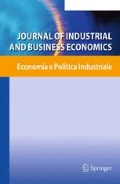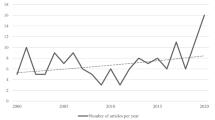Abstract
By tracking more than 3000 manufacturing firms established in 1999 in China over a span of 10 years, we examined whether the status of firm survival differs in China from the so-called stylized fact that has been established in studies for other countries. We also analyzed the unique effects of ownership and productivity on firm survival in a transitional economy. The empirical evidence suggests that although the state-owned firms are still under the protection from the Chinese government, productivity influences firm survival, the effects of government protection and market selection shift over time and in various growth rate sectors, and productivity exerts a different influence on exit This paper again confirms again that some evidence independent of various institutions and policies establishes the “natural law” of industrial dynamics, and “good” economy transition can make room for market selection.
Similar content being viewed by others
Notes
We selected 100 firms at first, and succeed in tracking 41 firms with this method.
In China, under the following conditions a firm may be withdrawn or revoked its business license: false registration, operation beyond the registered scope of business, not open or closed with no reason, and failure to pass the annual inspection.
Through checking the information from firms’ annual reports, websites and other materials, we find firms cancelling their business licenses may occur through the following situations: bankruptcy, long or short period net loss, merger or acquisition.
Joint venture includes not only funds from a foreign country but also from Hong Kong, Taiwan, and Macao.
Resource: http://finance.stockstar.com/finance/macrodata/ppilist.aspx (1999–2009).
Resource: http://data.eastmoney.com/cjsj/pmi.html (2005–2009).
Resource: http://www.stats.gov.cn/tjsj/ndsj/2013/indexch.htm (1999–2009).
Resource: http://data.stats.gov.cn/ (1999–2009).
In this regression, we didn’t employ the sample data from the year of 1999–2009 (showed in previous study), but of 2000–2008, as we set 1999 as observation start point and 2009 as end point. At the same time, we eliminated part of the sample due to some index value outlier(s?) or missing(Missing what?), and the same situation occurs in next studies.
References
Agarwal, R., & Audretsch, D. B. (2001). Does entry size matter? The impact of the life cycle and technology on firm survival. Journal of Industrial Economics, 49, 21–43.
Agarwal, R., & Gort, M. (2002). Firm and product life cycle and firm survival. American Economic Review, 92, 184–190.
Anderson, J. H., Lee, Y., & Murrell, P. (2000). Competition and privatization amidst weak institutions: evidence from Mongolia. Economic Inquiry, 38(4), 527–549.
Audretsch, D. B. (1995). Innovation and industry evolution. Cambridge: The MIT Press.
Audretsch, D. B., Houweling, P., & Thurik, A. R. (2000). Firm survival in the Netherlands. Review of Industrial Organization, 16, 1–11.
Audretsch, D. B., & Lehmann, E. E. (2005). The effects of experience, ownership, and knowledge on IPO survival: Empirical evidence from Germany. Review of Accounting and Finance, 4, 13–33.
Audretsch, D. B., & Mahmood, T. (1991). The hazard rate of new establishments: a first report. Economics Letters, 36(4), 409–412.
Audretsch, D. B., & Mahmood, T. (1994). The rate of hazard confronting new firms and plants in U.S. manufacturing. Review of Industrial Organization, 9, 41–56.
Audretsch, D. B., & Mahmood, T. (1995). New firm survival: new results using a hazard function. The Review of Economics and Statistics, 97–103.
Aw, B. Y., Chen, X. M., & Roberts, M. J. (2001). Firm-level evidence on productivity differentials and turnover in Taiwanese manufacturing. Journal of Development Economics, 66, 51–86.
Bernard, A. B., & Jensen, J. B. (2007). Firm structure, multinationals, and manufacturing plant deaths. The Review of Economics and Statistics, 89, 193–204.
Caves, R. E. (1998). Industrial organization and new findings on the turnover and mobility of firms. Journal of economic literature, 1947-1982.
Caves, R. E., & Porter, M. E. (1976). Barriers to exit, essays on Industrial Organization in Honor of Joe S. Bain. Cambridge: Ballinger.
Cox, D. R. (1972) Regression models and life-tables. Journal of the Royal Statistical Society. Series B (Methodological), 187–220.
Esteve, S., & Manez, J. (2008). The resource-based theory of the firm and firm survival. Small Business Economics, 30, 231–249.
Esteve, S., Sanchis, A., & Sanchis, J. A. (2004). The determinants of survival of Spanish manufacturing firms. Review of Industrial Organization, 25, 251–273.
Geroski, P. A. (1995). What do we know about entry? International Journal of Industrial Organization, 13, 421–440.
Hopenhayn, H. (1992). Entry, exit, and firm dynamics in long-run equilibrium. Econometrica, 60, 1127–1150.
Jacobson, L. (1985). Analysis of the accuracy of SBA's Small Business Data Base. Center for Naval Analysis, Alexandria, Va.
Jovanovic, B. (1982). Selection and the evolution of industry. Econometrica, 50, 649–670.
Kastl, J., Martimort, D., & Piccolo, S. (2013). Delegation, ownership concentration and R&D spending: Evidence from Italy. The Journal of Industrial Economics, 61, 84–107.
Katayama, H., Lu, S., & Tybout, J. R. (2009). Firm-level productivity studies: Illusions and a solution. International Journal of Industrial Organization, 27, 403–413.
Kornai, J. (1979). Resource-constrained versus demand-constrained systems. Econometrica, 47, 801–819.
Kornai, J. (1992). The Socialist System: The Political Economy of Communism: The Political Economy of Communism. Oxford University Press.
Kronborg, D., & Thomsen, S. (2008). Foreign ownership and long-term survival. Strategic Management Journal, 30, 207–219.
Liu, L. L. (1993). Entry-exit, learning, and productivity change: Evidence from Chile. Journal of Development Economics, 42, 217–242.
Manjon-Antolin, M. C., & Arauzo-Carod, J. (2008). Firm survival: Method and evidence. Empirica, 35, 1–24.
Mata, J., & Portugal, P. (2002). The survival of new domestic and foreign-owned firms. Strategic Management Journal, 23, 323–343.
Mata, J., & Portugal, P. (2004). Patterns of entry, post-entry growth and survival: A comparison between domestic and foreign owned firms. Small Business Economics, 22, 283–298.
Mayer, C., & Alexander, I. (1990). Banks and securities markets: Corporate financing in Germany and the United Kingdom. Journal of the Japanese and International Economies, 4(4), 450–475.
Nachum, L. (2003). Liability of foreignness in global competition? Financial service affiliates in the city of London. Strategic Management Journal, 24, 1187.
Reynolds, S. S. (1998). Plant closing and exit behavior in declining industry. Economica, 55, 493–503.
Shiferaw, A. (2009). Survival of private sector manufacturing establishments in Africa: The role of productivity and ownership. World Development, 37, 572–584.
Steensma, H. K., & Lyles, M. A. (2000). Explaining IJV survival in a transitional economy through social exchange and knowledge-based perspectives. Strategic Management Journal, 21, 831–851.
Strotmann, H. (2007). Entrepreneurial survival. Small business. Economics, 28, 87–104.
Taymaz, E., & Özler, Ş. (2007). Foreign ownership, competition, and survival dynamics. Review of Industrial Organization, 32, 23–42.
Tybout, J. R. (1996). Heterogeneity and productivity growth: Assessing the evidence. Industrial evolution in developing countries: Micro patterns of turnover, productivity, and market structure (pp. 43–72). New York: Oxford University Press.
Tybout, J. R. (2000). Manufacturing firms in developing countries: How well do they do, and why? Journal of Economic literature, 11–44.
Walder, A. G. (1995). Local governments as industrial firms: An organizational analysis of China’s transitional economy. American Journal of Sociology, 101, 263–301.
Zhang, W., Zhou, L., & Gu, Q. (2003). The mechanism of firm exit in economics transition: An empirical analysis for Zhongguancun Science Park of Beijing. Economic Research Journal, 106, 3–14.
Acknowledgments
The National Science Council in China funded the study under the project No. 71203023.
Author information
Authors and Affiliations
Corresponding author
Rights and permissions
About this article
Cite this article
Audretsch, D., Guo, X., Hepfer, A. et al. Ownership, productivity and firm survival in China. Econ Polit Ind 43, 67–83 (2016). https://doi.org/10.1007/s40812-015-0021-6
Received:
Accepted:
Published:
Issue Date:
DOI: https://doi.org/10.1007/s40812-015-0021-6




